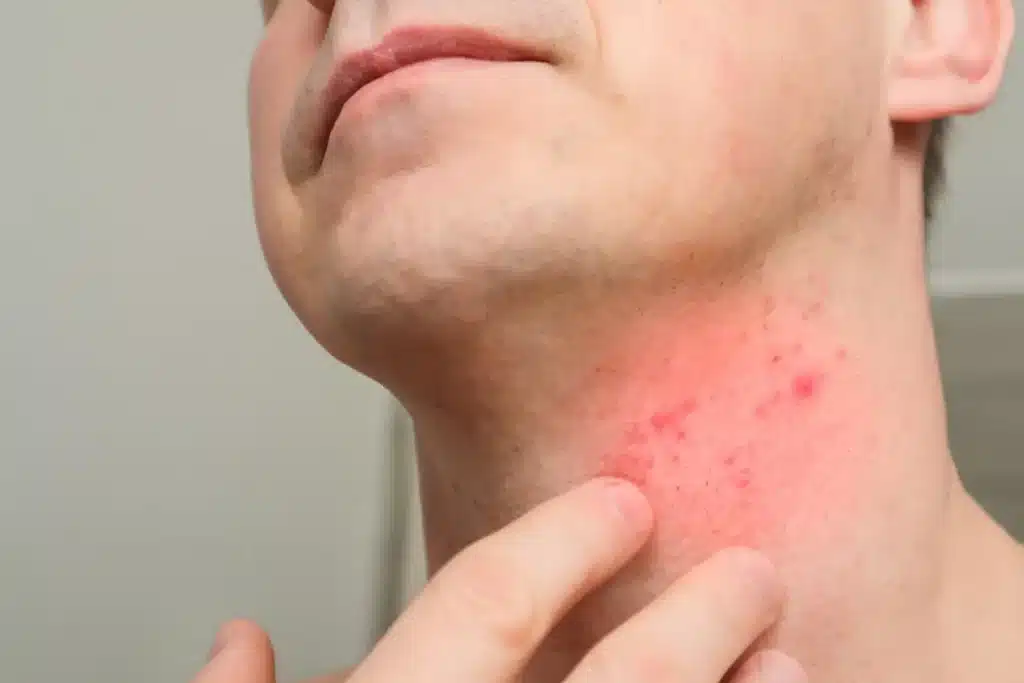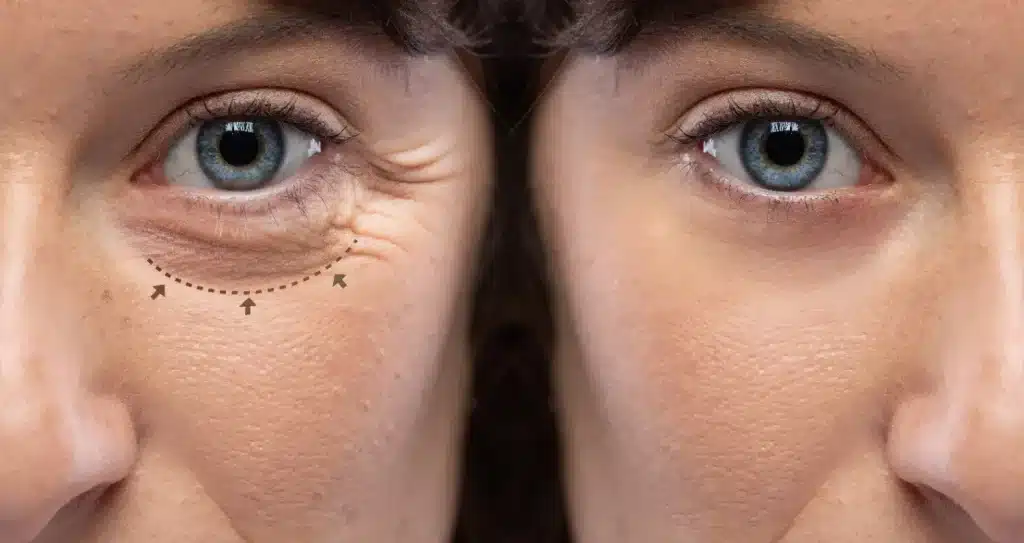Achieving weight loss goals is a significant accomplishment for many people. However, the journey doesn’t end there.
After shedding excess kilos, one common concern arises for patients – saggy and loose skin. As aesthetic doctors, you play a crucial role in helping clients tighten their skin and enhance their overall appearance. This article will explore various techniques, treatments, and considerations for effectively tightening excess skin after weight loss.
Skin’s Elasticity
Before diving into the specific treatments, it’s essential to understand the role of skin elasticity.
The skin is a remarkable organ that has the ability to stretch and contract. However, when a person loses a significant amount of weight, the skin often fails to return to its original shape due to age, genetics, and the duration of weight gain.
Different body areas are more prone to loose skin, including the abdomen, arms, thighs, breasts, and face. Doctors must assess each patient’s skin type and condition to determine the most suitable treatment options.
Pre-Treatment Preparations
Before developing a comprehensive treatment plan for loose skin after weight loss, the doctor must thoroughly evaluate the patient’s skin elasticity, texture, and any specific areas of concern. This assessment will help determine the severity of skin laxity and guide treatment decisions.
Having an open and honest conversation with clients about what can be achieved realistically through skin-tightening treatments is vital. While significant improvements can be made, complete restoration to pre-weight loss skin may not always be possible. Ensure clients understand the limitations and potential outcomes of the chosen treatments.
A multidisciplinary approach to weight loss and skin tightening is crucial. Collaborating with nutritionists and fitness trainers can help clients achieve better overall results by maintaining a healthy lifestyle, exercising regularly, and having a balanced nutrition plan.
The emotional aspect of skin tightening after weight loss also should not be overlooked. Many individuals struggle with body image concerns and may experience mixed emotions during their journey.
Create a safe, non-judgmental space for patients to express concerns about their body image. Validate their feelings and reassure them that their problems are meaningful and understandable. Encourage self-acceptance and self-care and help your patients shift their focus towards overall wellness and self-love rather than solely fixating on physical appearance.
Non-Surgical Techniques for Skin Tightening
Non-surgical skin tightening treatments have gained popularity recently due to their effectiveness and minimal downtime. Aesthetic practitioners have various options at their disposal, including:
- Radiofrequency (RF) treatments: RF technology enters the skin tissues, stimulating collagen production and promoting skin tightening. These treatments are safe, non-invasive, and can be used on different body areas.
- Ultrasound therapy: Utilizing high-intensity focused ultrasound (HIFU), this treatment delivers ultrasound energy to the deeper layers of the skin, triggering collagen production and promoting skin firmness.
- Laser treatments: Laser technology can improve skin tightness by stimulating collagen production and remodeling the skin’s supportive structures. Fractional laser resurfacing and ablative laser treatments are commonly used for this purpose.
- Microneedling, or collagen induction therapy, involves creating tiny punctures in the skin using fine needles. These micro-injuries promote collagen production and skin tightening. With radiofrequency energy, the treatment becomes even more effective. Using microneedling with serums or growth factors can further enhance its effects.
- Cryotherapy and cold-based treatments: Cryotherapy involves applying extreme cold to the skin, causing vasoconstriction and stimulating collagen production. Cold-based therapies like cryolipolysis can also help tighten loose skin after weight loss in specific areas.
- Dermal fillers and injectables: While not directly targeting skin tightening, strategically placed dermal fillers (for example, Juvederm, Restylane, or Sculptra) can provide structural support, resulting in a more lifted and tightened appearance. These treatments can indirectly contribute to tighter and more youthful-looking skin by addressing the problem areas directly.
- Chemical peels can improve skin texture, promote collagen production, and enhance the overall skin appearance. By exfoliating the rearmost layer of the skin, chemical peels stimulate cell turnover and reveal healthier, tighter skin beneath. Different types of peels, such as superficial or medium-depth peels, can be selected based on the patient’s needs and skin condition.
- Mesotherapy involves injecting a customized blend of vitamins, minerals, antioxidants, and other beneficial substances into the skin. Products like Teosyal PureSense Redensity I, Restylane Skinboosters Vital, Stylage, and Juvederm Volite are very helpful in these types of treatments. The injections nourish the skin, stimulate collagen production, and improve overall skin quality. Mesotherapy can be a valuable addition to skin tightening treatments, providing additional support and nourishment to the skin.
- Growth factors and peptides: Skin care products containing growth factors and peptides can promote collagen synthesis and enhance the skin’s elasticity. These ingredients can be found in serums, creams, or masks and can be recommended as part of a daily skin care routine to support the skin-firming process.
- Retinoids, such as retinol or prescription-strength retinoids, are well-known for increasing collagen production, improving skin texture, and reducing fine lines and wrinkles. These products can be recommended to clients to enhance skin firmness and tighten loose skin over time. Educating clients on the proper usage and potential side effects of retinoids, such as skin and sun sensitivity, is essential.
Surgical Options for Skin Tightening
In some cases of significant skin laxity, non-invasive treatments are not enough, and surgical interventions may be necessary. Some surgical options for skin tightening include:
- Body contouring: These comprehensive surgical procedures address loose skin in multiple body areas, like the abdomen, arms, thighs, and buttocks. Body contouring surgeries such as a lower body lift or belt lipectomy can dramatically improve the body’s shape and restore skin tightness.
- Abdominoplasty (tucking loose tummy skin) targets excess skin and fat in the abdominal area, resulting in a flatter and more toned appearance. Abdominoplasty is commonly performed on patients who have experienced significant weight loss.
- Brachioplasty (arm lift) removes excess skin and fat from the upper arms, resulting in tighter and more defined arms. This procedure is ideal for individuals with sagging skin in the upper arm area.
- Thigh lift addresses loose thigh skin by removing excess skin after weight loss and reshaping the thigh contours. Depending on the patient’s specific needs, it can be done on the inner or the outer thighs.
- Breast lift: Weight loss can often lead to sagging breasts. A breast lift surgery lifts and reshapes the breasts by removing excess skin and repositioning the nipple-areola complex to achieve a better aesthetic effect.
- Face and neck lift involves tightening the underlying facial muscles and removing excess skin, resulting in a more youthful and rejuvenated appearance.
Post-Treatment Care and Maintenance
Dermal treatments play a vital role for tightening excess skin, though post-treatment care and maintenance are just as important to achieve long-lasting results. As an aesthetic doctor, you have the expertise to make recommendations to patients and administer various treatments and products intended to support and enhance these effects. Guide your patients through the following steps:
- Use skin care routines and products that promote collagen production, improve skin elasticity, and hydrate the skin. Ingredients such as retinol, hyaluronic acid, and peptides can be beneficial. Encourage patients to follow a consistent skin care routine tailored to their skin type and aesthetic concerns.
- Sun protection is vital in maintaining skin health and preventing further damage. Patients must use broad-spectrum sunscreen daily, wear protective clothing, and seek shade when necessary.
- Regular exercise, proper nutrition, and hydration are essential in maintaining overall skin health. A healthy lifestyle contributes to the body’s natural ability to repair and regenerate, supporting skin-tightening procedures.
Always consider the patient’s skin type, concerns, and treatment goals when recommending skin care treatments and products. Tailor the recommendations based on their specific needs to ensure optimal results. You should also provide clear instructions on product usage, frequency, and any potential side effects to maximize the benefits of the treatments while minimizing the associated risks.
Precautions and Potential Side Effects
While skin-tightening treatments can yield impressive results, exercising caution and discussing potential risks and complications with patients is essential.
Educate clients about the possible side effects associated with each treatment option, including:
- potential discomfort;
- redness;
- swelling;
- bruising;
- in rare cases, more severe complications.
Doctors must provide detailed instructions on post-treatment care, including proper wound care, avoiding excessive sun exposure, and following any necessary restrictions or guidelines. Clear communication will help patients achieve optimal results and minimize the risk of complications.
Conclusion
A sudden loss of a large fat mass could severely impact the skin, causing it to lose elasticity and tightness. Traditional methods for handling excess skin may not be enough to combat this issue. Patients will require aesthetic procedures – vacuum and compression massage, mesotherapy, ultrasound, cryotherapy, etc., or even surgery.
That said, beauty clinic procedures do not eliminate the need for proper skin care at home. Only complex therapy and determined perseverance will help the patients achieve their goal of having firm skin after weight loss.
FAQ
How long does loose skin take to tighten?
The time it takes to tighten skin after weight loss varies from person to person and depends on several factors, including:
- Age – younger people tend to have more elastic skin, which can bounce back faster than it would in older individuals.
- Degree of weight loss – individuals who have lost a significant amount of weight may experience more p loose skin that may take longer to tighten.
- Genetics – some individuals may naturally have more resilient skin, while others may be more prone to loose skin.
- Rate of weight loss – rapid fat loss can increase the likelihood of loose skin as the skin doesn’t have enough time to adapt to the changes. Gradual weight loss allows the skin to adjust more slowly, potentially minimizing the effect of loose skin.
- Overall skin health can dramatically affect how well the skin will react to drastic body changes such as sudden weight loss.
Generally, the skin’s natural tightening process is believed to take several months to a year or more. During this time, the body produces collagen and elastin, which helps improve both its elasticity and tightness. Regular exercise, proper hydration, and a healthy lifestyle are all essential in supporting these processes.
It’s worth noting that a complete restoration of the skin’s tightness to its pre-weight loss state may not always be possible. Sometimes, loose skin may never fully tighten without additional interventions such as surgical procedures.
References
Elander, A., Biörserud, C., Staalesen, T., Ockell, J., & Fagevik Olsén, M. (2019). Aspects of excess skin in obesity, after weight loss, after body contouring surgery and in a reference population. Surgery for obesity and related diseases: official journal of the American Society for Bariatric Surgery, 15(2), 305–311. https://doi.org/10.1016/j.soard.2018.10.032.
What can people do to firm up saggy skin? Medical News Today. https://www.medicalnewstoday.com/articles/saggy-skin.
Fields, L. You Lost the Weight. What About That Extra Skin? Web MD. https://www.webmd.com/obesity/features/you-lost-weight-what-about-extra-skin.
Lotfi P, Engdahl R. Concepts and Techniques in Postbariatric Body Contouring: A Primer for the Internist. Am J Med. 2019 Sep;132(9):1017-1026. doi: 10.1016/j.amjmed.2019.02.048. Epub 2019 Mar 21. PMID: 30904509.
Waltzman, J. T., Zins, J. E., & Couto, R. A. (2019). Face and Neck Lifting After Weight Loss. Clinics in plastic surgery, 46(1), 105–114. https://doi.org/10.1016/j.cps.2018.08.012.
Colicchia, G. M., Di Pietro, V., & Cervelli, V. (2019). Mastoplasty after Massive Weight Loss: Redefinition and Stabilization of the Breast Mound with Submuscular Autoprosthesis. Journal of cutaneous and aesthetic surgery, 12(3), 164–173. https://doi.org/10.4103/JCAS.JCAS_48_18.
Couto, R. A., Charafeddine, A. H., & Zins, J. E. (2019). Facelift in Patients with Massive Weight Loss. Clinics in plastic surgery, 46(4), 559–571. https://doi.org/10.1016/j.cps.2019.05.003.



















